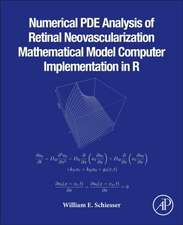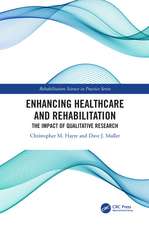Healthcare Sensor Networks: Challenges Toward Practical Implementation
Editat de Daniel Tze Huei Lai, Marimuthu Palaniswami, Rezaul Beggen Limba Engleză Paperback – 19 sep 2019
Healthcare Sensor Networks: Challenges Toward Practical Implementation discusses the fundamental concepts in designing and building such networks. It presents the latest developments in HSNs, explores applications of the technology, and provides insights into practical design and deployment challenges. Bringing together contributions from international experts in the field, the book highlights the key areas that require further research for HSNs to become a technological and commercially viable reality.
The first part of the book concentrates on the engineering challenges, covering new biosensors, energy harvesting techniques, new wireless communication methods, and novel security approaches. Building from single sensing devices to networked sensing systems, the second part of the book looks at various health applications of HSNs. It addresses the human-centric requirements that should be considered in the design of HSN technologies—cost, portability, functionality, and user acceptance—and demonstrates how engineering compromises must be made in HSN solutions.
A useful and timely resource for researchers, postgraduate students, and engineers looking for innovative solutions in healthcare, this book will also be of interest to medical and allied he
| Toate formatele și edițiile | Preț | Express |
|---|---|---|
| Paperback (1) | 495.83 lei 43-57 zile | |
| CRC Press – 19 sep 2019 | 495.83 lei 43-57 zile | |
| Hardback (1) | 1337.26 lei 43-57 zile | |
| CRC Press – 28 sep 2011 | 1337.26 lei 43-57 zile |
Preț: 495.83 lei
Preț vechi: 583.33 lei
-15% Nou
Puncte Express: 744
Preț estimativ în valută:
94.88€ • 99.31$ • 78.97£
94.88€ • 99.31$ • 78.97£
Carte tipărită la comandă
Livrare economică 31 martie-14 aprilie
Preluare comenzi: 021 569.72.76
Specificații
ISBN-13: 9780367382339
ISBN-10: 0367382334
Pagini: 462
Dimensiuni: 156 x 234 x 33 mm
Greutate: 0.64 kg
Ediția:1
Editura: CRC Press
Colecția CRC Press
ISBN-10: 0367382334
Pagini: 462
Dimensiuni: 156 x 234 x 33 mm
Greutate: 0.64 kg
Ediția:1
Editura: CRC Press
Colecția CRC Press
Public țintă
Academic and Professional ReferenceCuprins
Sensor Networks in Healthcare: A New Paradigm for Improving Future Global Health. Healthcare and Accelerometry: Applications for Activity Monitoring, Recognition, and Functional Assessment. Intrabody Communication Using Contact Electrodes in Low-Frequency Bands. The Prospect of Energy-Harvesting Technologies for Healthcare Wireless Sensor Networks. Addressing Security, Privacy, and Efficiency Issues in Healthcare Systems. Flexible and Wearable Chemical Sensors for Noninvasive Biomonitoring. Monitoring Walking in Health and Disease. Motion Sensors in Osteoarthritis: Prospects and Issues. The Challenges of Monitoring Physical Activity in Children with Wearable Sensor Technologies. Ambulatory and Remote Monitoring of Parkinson’s Disease Motor Symptoms. Nocturnal Sensing and Intervention for Assisted Living of People with Dementia. Experiences in Developing a Wearable Gait Assistant for Parkinson’s Disease Patients. Designing Low-Cost ECG Sensor and Monitor: Practical Considerations and Measures. Sensors, Monitoring and Model-Based Data Analysis in Sports, Exercise and Rehabilitation. Robust Monitoring of Sport and Exercise. Index.
Notă biografică
Dr. Daniel T.H. Lai received his bachelor of electrical and computer systems engineering (Hons) and PhD in electrical and computer systems from Monash University, Melbourne, Australia. He was a postdoctoral research fellow at the University of Melbourne and Victoria University (2007-2010). He is currently with the Faculty of Health, Engineering and Science at Victoria University (2011). His research interests include computational intelligence and sensor network technology for healthcare and sports applications. This involves the design of new noninvasive and proactive sensing technologies capable of detecting, diagnosing, and predicting health risks. He has more than 50 peer-reviewed publications and is a current reviewer for several international journals, including IEEE Transactions of Information Technology and Biomedicine, Journal of Biomechanics, and Sensors and Actuators. He is also actively involved in the organization of several workshops and international conferences.
Prof. Rezaul K. Begg received his BSc and MSc Eng degrees in electrical and electronic engineering from Bangladesh University of Engineering and Technology (BUET), Dhaka, and his PhD in biomedical engineering from the University of Aberdeen, UK. Currently he is a Professor within the Biomechanics Unit at Victoria University, Melbourne, Australia. Previously, he worked with the University of Aberdeen, Deakin University, and BUET. His research interests are in biomedical engineering, gait biomechanics, and machine learning. He has published more than 160 research papers in these areas. He is on the editorial board for several international journals and regularly reviews submissions for more than 15 international journals. He has also been actively involved in organizing a number of major international conferences. He has received several awards for academic excellence, including the ICISIP 2005 Best Paper Award, the Vice C
Prof. Rezaul K. Begg received his BSc and MSc Eng degrees in electrical and electronic engineering from Bangladesh University of Engineering and Technology (BUET), Dhaka, and his PhD in biomedical engineering from the University of Aberdeen, UK. Currently he is a Professor within the Biomechanics Unit at Victoria University, Melbourne, Australia. Previously, he worked with the University of Aberdeen, Deakin University, and BUET. His research interests are in biomedical engineering, gait biomechanics, and machine learning. He has published more than 160 research papers in these areas. He is on the editorial board for several international journals and regularly reviews submissions for more than 15 international journals. He has also been actively involved in organizing a number of major international conferences. He has received several awards for academic excellence, including the ICISIP 2005 Best Paper Award, the Vice C
Descriere
From network deployment to secure monitoring, this book addresses the latest developments in healthcare sensor networks—medical monitoring devices implanted on the body or in the surrounding infrastructure. The text discusses fundamental concepts and provides examples of clinical applications, including sensors to monitor physical activity in children and wearable gait assistants for people with Parkinson’s. Each chapter details a separate challenge in design and implementation. Addressing topics ranging from sensor hardware and the demand for higher data bandwidth to portability and cost, the book highlights the key areas that require further research for HSNs to become a technological and commercially viable reality.
























